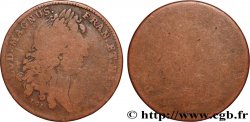fjt_223678 - TRÉSOR ROYAL Trésoriers de France à Paris 1598
non disponibile.
Articolo venduto sul nostro negozio (2019)
Prezzo : 180.00 €
Articolo venduto sul nostro negozio (2019)
Prezzo : 180.00 €
Tipo : Trésoriers de France à Paris
Data: 1598
Metallo : ottone
Diametro : 28 mm
Asse di coniazione : 6 h.
Orlo : lisse
Grado di rarità : R2
Commenti sullo stato di conservazione:
Point de corrosion sur le listel
N° nelle opere di riferimento :
Diritto
Titolatura diritto : LES. TRESORIERS. DE. FRANCE. A. PARIS.
Descrittivo diritto : Écu de France et de Navarre entourés des deux colliers des Ordres du Roi.
Rovescio
Titolatura rovescio : FRAVS. VIRTVTE. PERIT ; À L'EXERGUE : 1598.
Descrittivo rovescio : Lion égorgeant un renard.
Traduzione rovescio : La ruse est anéantie par la vaillance.
Commento
Ce jeton a un revers que l’on retrouve pour les Corre 2809 (N. Le Camus, officier à la Cour des Monnaies) 2237 (Guinot) et 2314 (Monogramme non identifié). Il semble donc que ce type de revers est général pour les trésoriers ou controleurs des monnaies mais l’explication de Feuardent est plus intriguante. Le renard serait pour Robert Dudley, duc de Leicester, qui conseilla à Elisabeth Ier d’empoisonner Marie Stuart, voir http://fr.wikipedia.org/wiki/Robert_Dudley .
This token has a reverse that is found for Corre 2809 (N. Le Camus, officer at the Cour des Monnaies) 2237 (Guinot) and 2314 (unidentified monogram). It therefore seems that this type of reverse is general for treasurers or controllers of coins but Feuardent's explanation is more intriguing. The fox would be for Robert Dudley, Duke of Leicester, who advised Elizabeth I to poison Mary Stuart, see http://fr.wikipedia.org/wiki/Robert_Dudley
This token has a reverse that is found for Corre 2809 (N. Le Camus, officer at the Cour des Monnaies) 2237 (Guinot) and 2314 (unidentified monogram). It therefore seems that this type of reverse is general for treasurers or controllers of coins but Feuardent's explanation is more intriguing. The fox would be for Robert Dudley, Duke of Leicester, who advised Elizabeth I to poison Mary Stuart, see http://fr.wikipedia.org/wiki/Robert_Dudley








 Segnalare un errore
Segnalare un errore Stampate la pagina
Stampate la pagina Condividi mia selezione
Condividi mia selezione Fai una domanda
Fai una domanda Consegnare / vendere
Consegnare / vendere
 Descrittivo
Descrittivo









